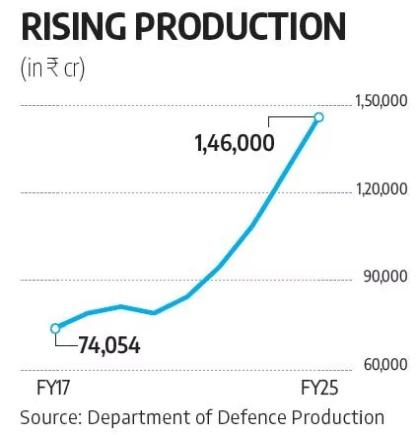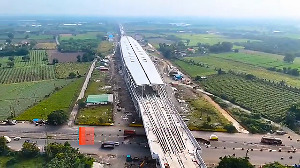'Make-in-India played a key role in India's effective action against terrorism during Operation Sindoor.'

India's defence budget could rise a little under five fold to Rs 31.7 trillion in 2047 from ₹6.81 trillion in 2025-2026 (FY26), with defence production increasing over sixfold to ₹8.8 trillion from ₹1.46 trillion in FY25, suggest the Defence Industrial Sector Vision 2047 report of the Confederation of Indian Industry and KPMG India.
The report -- titled Atmanirbhar, Agrani, and Atulya Bharat 2047 -- unveiled at the CII Annual Business Summit in New Delhi, also estimates India's defence exports to rise to Rs 2.8 trillion in 2047, up nearly twelve fold from ₹24,000 crore (₹240 billion) in FY25.
Similarly, total research and development (R&D) expenditure could jump from 4 per cent of the defence budget at present to 8 to 10 per cent, and defence spend could increase from 2 per cent of (GDP to 4 to 5 per cent.
Terming these figures milestones, the report underlines three conditions that have to be met in the coming years to achieve these.
The report notes that achieving the vision of India as a developed nation by 2047, particularly through a strengthened defence sector, faces several roadblocks and challenges: 'Budgetary constraints could limit the necessary investments in modernising the armed forces and developing indigenous military technologies. Additionally, regulatory red tape and procedural quagmire often slow down defence procurement and indigenous R&D initiatives, creating inefficiencies.
'Dependence on defence imports for critical technologies remains a significant challenge, hindering self-reliance and innovation... Furthermore, there is a shortage of skilled manpower to drive advanced technological developments and manage sophisticated defence systems.'

Stating that fostering robust public-private partnerships is necessary, the report argues this remains challenging because the private sector needs incentives and support to enter and sustain in the defence manufacturing domain.
'Intellectual property rights and technology-transfer issues with foreign collaborators also present obstacles in achieving self-reliance. Addressing these challenges requires strategic planning, increased Budget allocations, streamlined procedures, robust policy frameworks, and fostering a culture of innovation and collaboration between the public and private sectors.'
Highlighting India's aspirations to emerge as a leading nation in the global defence hierarchy, the report lists 'strategic vectors' that break down this vision into three specific objectives.
First, the report calls for achieving enhanced self-reliance in defence production and capabilities by 2032, by targeting critical areas for comprehensive indigenous development, reducing dependence on foreign suppliers, and fostering innovation through domestic R&D and manufacturing excellence.
Second, by 2038, the report sees India becoming one of the top-five global exporters of high-quality defence equipment and technology by expanding international partnerships, meeting global standards, and vigorously promoting defence products in international markets.
Third, by 2045, it calls on India to become a world leader in developing and deploying cutting-edge niche technologies across the defence sector, by encouraging collaboration between industry, academia, and government, and driving substantial investments in futuristic R&D.
By committing to these vectors, the report says, India can turn its aspirations into reality.
India's Defence Production Hits All-Time High

India's annual defence production reached an all-time high of ₹1.46 trillion in 2024-2025 (FY25), marking an almost 15 per cent jump from the previous record of ₹1.27 trillion in FY24, Defence Minister Rajnath Singh said last week.
Defence exports also hit a record high in the previous financial year, crossing ₹24,000 crore, an increase of nearly 14 per cent from ₹21,083 crore (Rs 210.83 billion) in FY24, the raksha mantri stated.
Singh also highlighted the private sector's contribution, which stood at over ₹32,000 crore (Rs 320 billion), about 22 per cent of the total defence production.
The private sector's share in the value of production in FY24 was 20.8 per cent.
Addressing the CII's annual business summit in New Delhi, the defence minister also emphasised that, for the first time, the private sector would have the opportunity to participate in a major defence project alongside public sector companies, under the Advanced Medium Combat Aircraft (AMCA) programme execution model approved on May 27, 2025.
'Under the AMCA project, the plan is to develop five prototypes, which will be followed by series production. It is a key milepost in the history of the Make-in-India programme,' he said.

The defence minister said that India's rise as the fourth-largest economy was a matter of great pride, as he underlined the significant role of the defence sector in the country's growth.
'Ten to eleven years ago, our defence production was approximately ₹43,000 crore. Today, it has crossed the record figure of ₹1.46 trillion, with a contribution of over ₹32,000 crore by the private sector,' he said.
'Our defence exports, which were around ₹600 crore to ₹700 crore 10 years ago, have surpassed a record figure of ₹24,000 crore today. Our weapons, systems, sub-systems, components, and services are reaching around 100 countries.'
Commenting on Operation Sindoor, Singh said, 'Make-in-India is an essential component in our national security and it played a key role in India's effective action against terrorism during Operation Sindoor.'
Emphasising the role of indigenous defence capabilities in enabling decisive action, the defence minister added, 'We destroyed the terrorist hideouts and then the military bases. We could have done a lot more, but we presented a great example of coordination of power and restraint.'
At the same event, Defence Secretary Rajesh Kumar Singh addressed the private sector, assuring that the government would extend it the same support it had historically provided to the public sector.
'I will be striving to improve the ease of doing business, to create a level playing field, and hopefully even bury you under orders,' he said.
Highlighting how prolonged procurement procedures had previously caused decade-long acquisition delays, created capability gaps for the armed forces, and left portions of the defence modernisation budget unspent in several years, the secretary said the situation was now changing.
'In the last financial year (FY25), we have, for the first time in five years, exhausted our modernisation budget. More importantly, we signed contracts worth ₹2 trillion, double the previous record of about ₹1 trillion in FY24,' Defence Secretary Singh said.
The secretary expressed hope that this momentum would accelerate the pace of military modernisation.
'If we can sustain this level of utilisation, we are also in a better position to approach both the ministry of finance and the Finance Commission with requests for higher allocations, particularly for the modernisation budget for our armed forces,' he said.
While noting that the defence budget remains substantial even at 1.9 per cent of GDP, he added, 'Factoring in the power of compounded growth on a $4 trillion GDP, I am sure it will be more than adequate to meet our modernisation requirements, subject to the absorptive capacity of the ministry of defence, in terms of signing contracts, and in the industry for gearing up to fulfil these contracts.'
Feature Presentation: Rajesh Alva/Rediff











